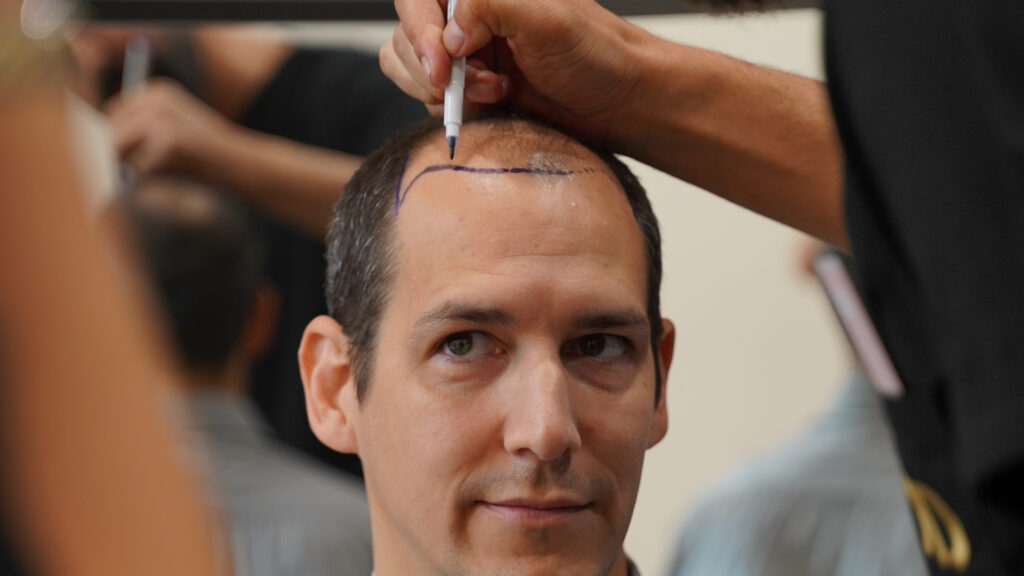Are you suffering from degraded teeth, with partial or complete edentulism, due to tooth decay, congenital problems, or following an accident ? Don’t neglect your problem : it is strongly recommended to get your teeth done as soon as possible, in order to prevent your dental health from worsening, especially through a slow deterioration of the bones that support your damaged teeth. To achieve this, dental implants with ALL-on-6 implants are the best way to permanently restore your smile and your chewing ability to a natural, aesthetic appearance and function.
What is an ALL-on-6?
The ALL-on-6 dental implant procedure is the creation of a complete dental prosthesis, anchored to the jawbone (top) or mandible (bottom) by six titanium implants, integrated into the gum and evenly distributed along the jaw. An arch, topped with false gums and ceramic or porcelain dentures, completes the device by screwing onto the six implants embedded in the jaw. This orthodontic treatment, which has the advantage of being able to be implanted even on a low volume of jawbone, is intended for patients whose mouths are completely or partially edentulous in one or two jaws, or who have advanced deterioration of many teeth. It corrects a bite defect, restoring more harmonious proportions to the lower face.
The ALL-on-6 procedure is usually performed in two sessions about four months apart while the implants integrate perfectly into the bone and gums. During this time, a temporary prosthesis is attached to the implants. The ALL-on-6 solution avoids the more invasive bone grafting and offers a faster recovery time and lower cost than other implant treatment techniques. In addition, the creation of a bridge with a false gum overlay does not require post-implant surgery like a sinus lift. If the jawbone is too thin, too weak or degraded, a bone graft will be prescribed. Usually created with synthetic biocompatible material, it reinforces the bone on which the implant will be implemented.
Unlike dentures, ALL-on-6 treatment is fixed and permanent : it does not require the use of adhesives, it does not move and it does not deteriorate over the years. If a traditional dental implant is used to replace isolated damaged teeth, this system is aimed at replacing a complete set of teeth on the upper and/or lower jaw. Most importantly, it avoids the deterioration of the jawbone that occurs when there are no natural or artificial tooth roots. In addition to a natural aesthetic appearance, ALL-on-6 dental implants also provide permanent, efficient and long-lasting chewing, allowing patients to enjoy life to the fullest. Finally, if the patient has a gum problem, it should be resolved prior to surgery with a gummy smile treatment.
ALL-on-6 vs. ALL-on-4: what are the differences?
The ALL-on-6 technique, like ALL-on-4, was developed in the 1990s by a Portuguese dentist, Paulo Malo, and funded by the Swedish company Nobel Biocare AB, which specializes in the production of dental implants, identifying it as an ideal alternative to other conventional dental implant techniques. In Turkey, the dental clinics chosen by Body Expert use the Straumann implants, considered as the best available dental implants. This orthodontic technique supports a fixed bridge, either with six implants evenly distributed along the jawbone, or with four implants, with the bottom implant anchored at an angle in the bone, when the bone is too degraded to accommodate six implants. Patients with substantial tooth loss, either at the top or bottom, are usually prescribed an ALL-on-6 implant for better chewing distribution and a more stable and solid implant. Depending on the patient’s condition, he or she will be prescribed one or the other solution. The ALL-on-4 allows the patient to regain good masticatory function in a shorter period of time, while a false gum will correct the occlusion invisibly. Last but not least, a ALL-on-4 needs the implementation of a half denture, whereas the ALL-on-6 is fully integrated to the dentition, without the need for a partial denture.

How does the ALL-on-6 work?
Depending on the condition of the patient’s teeth, several configurations of prosthesis or bridges screwed onto six implants are available. If the bone condition of the patient’s jaws permits, a bone filling or sinus lift may not be necessary. In cases of old edentulous premolars, a bone filling may be optimal. In these cases, a first session is necessary before implanting the screw anchors.
The ALL-on-6 is performed on healthy bone and consists of implanting six titanium anchors evenly distributed in the jaw (lower or upper depending on the need), so that the chewing thrust is well balanced throughout the prosthesis. An arch, made of false gum tissue and on which 10 to 12 zirconia, ceramic or porcelain teeth are mounted, will then be fixed on the implants with six titanium screws. Once the bridge is fixed in this way, it can be kept for at least 10 years, and up to 30 years, provided that good dental hygiene is followed. The patient’s teeth will then be aligned in a natural and aesthetic way, and he or she will be able to chew with ease.

Steps in the ALL-on-6 implant procedure
1- Placement of the six implants
The first step in setting up an ALL-on-6 is to prepare the place for the six dental implants, with an eventual bone graft to reinforce the anchoring of the implants, and a surface treatment (sandblasting and acid attack), to facilitate the bone integration. Using an x-ray to observe the bone condition and with a digital surgery guidance, the implantologist will select six different anchor points, strategically placed to ensure the best strength and stability of the prosthetic arch. He will then incise the gums, drill the jawbone and insert the titanium implants, which will be covered with a recovery cap, helping the screws to integrate into their bone and gum environment. This operation is performed under anesthesia (local or general depending on the case). Most patients are able to return to their normal lifestyle the day after this first operation.
2- Creation of a temporary prosthesis
During the same session, a 3D image of the treated jawbone will allow the dental surgeon to create a prosthesis with a set of temporary teeth that will be worn for several months while the implants integrate with the bone, and for an optimal healing of the gum healing. This way, the patient will not remain toothless during the healing phase.
3- Final implantation of the prosthesisAfter 2 to 6 months, once the implants are perfectly integrated and the healing completed, a second session will allow the final prosthesis to be fixed, custom-made by the prosthetist according to the 3-D images during the patient’s convalescence.
After surgery: living with an ALL-on-6
Recovery and convalescence
While it is possible to resume one’s life and return to work the day after the first session, a day of rest is recommended, especially in the case of general anesthesia. The patient will experience some discomfort and slight pain in the jaw after the operation, as with any oral surgery. The dentist will usually prescribe painkillers and anti-inflammatories (such as paracetamol), as well as an antibiotic to prevent any infection. It is also recommended to use an antibacterial mouthwash during the week following the surgery. Swelling of the operated area may also occur, as well as painful bruising, which should normally disappear after a few days. If necessary, a visit to the dentist may be necessary. Certain warning signs can be used to detect a possible rejection of the dental implant: absence of sensation when brushing or chewing, presence of bone around the implant (visible on an X-ray), absence of mobility… These cases are very rare, however: the post-operative success rate of the ALL-on-6 is close to 98%, with 2% of failures due to the rejection of the implant by the jawbone.
What to eat after implant placement
Despite the fact that many patients have a sweet tooth, it is strongly recommended to follow your dentist’s dietary advice after the placement of an ALL-on-6, in order to avoid disrupting the healing process and avoiding swelling and bleeding. This is an opportunity to go on a diet!
- 1 to 15 days: liquid or pureed foods: soups, smoothies, purées, yoghurts, compotes, soufflés for gourmets, provided that everything is not too hot or too cold…
- 15 to 30 days: soft foods are allowed, such as pasta, rice, cereals, eggs, fish, vegetables and soft fruits cut finely, always at medium temperature.
- 30 to 60 days: tender meats and well-cooked vegetables make a comeback, and you find yourself cooking up some good food in the oven…
- 60 days and beyond: chewing can resume at a moderate pace, and dietary constraints are no longer necessary, without immediately returning to hard foods!
To do this, you will have to wait until after the final and custom-made fitting of your ALL-on-6, i.e. 3 to 6 months after the implants have been fitted, to return to a completely normal diet. You will be able to enjoy life to the fullest for at least the next twenty years. As long as you practice good oral hygiene and go to your dentist for a check-up once a year…
How long does an ALL-on-6 last ?
According to the statistics available, and if the patient adopts strict dental hygiene, ALL-on-6 can last around 20 years, even 30 years. In Turkey, Body Expert includes a 2 years full guarantee on every ALL-on-6 implementation.
Advantages and disadvantages of ALL-on-6
Advantages :
In addition to the great possibility of regaining a beautiful smile, ALL-on-6 allows you to gain a strong, comfortable and functional dentition, coupled with a natural appearance of the mouth. In addition, it prevents bone degradation, gives the patient the pleasure of eating whatever they want, and is easy to maintain, much better than dentures or bridges. Finally, it is fixed, permanent and well integrated, avoiding denture “accidents”, and does not cause speech problems. And on the price side, even if the initial cost seems higher, the other alternatives (bridge, dentures…) must be replaced after a few years.
Disadvantages
As for the disadvantages, there are a few, albeit minor, that can be overcome with a little patience: the duration of the treatment, the time between the placement of the implants and the placement of the final prosthesis, and the dietary constraints imposed to ensure a successful integration.
Does the NHS cover ALL-on-6 dental implants ?
On very specific conditions, the National Health system in the UK covers the cost of dental implants. To be eligible, please refer to this guide, published by the Royal College of Surgeons in 2019, presenting all the eligibility criterias for NHS-funded dental implants. Among the concerned patients groups : people with missing or malformed teeth because of genetic conditions, with congenitally missing teeth (hypodontia), with cleft palate or lip resulting in missing teeth, aggressive periodontitis, facial trauma, with head or neck cancers, or missing teeth resulting from chemotherapy treatment, or patients who are missing all teeth and can’t wear dentures.
ALL-on-6: How much does it cost ?
By the complexity of an orthodontic operation, the brand of the chosen material and the specific case of each patient, who could need a bone graft, a sinus lift or a gummy smile treatment, it is very difficult to compare prices. Most important : the price of the titanium implants, who represent the biggest budget of an ALL-on_6 procedure. Our comparative focuses on the cost of a ALL-on-6 treatment with Straumann dental implants, considered as the best available brand on the market.
Beware : some dental clinics in certain foreign countries are using chinese copies of famous brands, whose quality is doubtful. For your teeth, require the best !
- The UK : 10000 to 12000 £
- The US : 24 000 to 30 000 $
- The Netherlands : 8000 to 12000 Euros
- Turkey : 4000 to 6000 Euros
23350 vues
0 commentaires
0






Il n'y a pas de commentaires pour le moment.